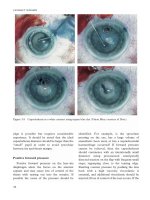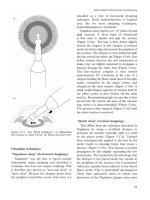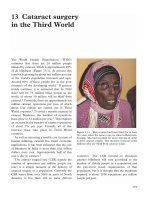Ebook Color atlas & synopsis of clinical ophthalmology pediatric ophthalmology (2/E): Part 1
Bạn đang xem bản rút gọn của tài liệu. Xem và tải ngay bản đầy đủ của tài liệu tại đây (8.77 MB, 182 trang )
EDITOR
Leonard B. Nelson, MD, MBA
Director, Strabismus Center
Co-Director, Pediatric Ophthalmology and Ocular Genetics
Wills Eye Hospital
Associate Professor of Ophthalmology and Pediatrics
Jefferson Medical College of Thomas Jefferson University
Philadelphia, Pennsylvania
SECTION EDITORS
Michael J. Bartiss, OD, MD
Caroline DeBenedictis, MD
Kammi B. Gunton, MD
Judith B. Lavrich, MD
Kara C. LaMattina, MD
Alex V. Levin, MD, MHSc, FRCSC
Scott E. Olitsky, MD
Bruce M. Schnall, MD
Aldo Vagge, MD, PhD student
Barry N. Wasserman, MD
SERIES EDITOR
Christopher J. Rapuano, MD
Director and Attending Surgeon, Cornea Service
Co-Director, Refractive Surgery Department
Wills Eye Hospital
Professor of Ophthalmology
Sidney Kimmel Medical College at Thomas Jefferson University
Philadelphia, Pennsylvania
Wills Eye Hospital
COLOR ATLAS & SYNOPSIS
OF
Clinical Ophthalmology
Pediatric
Ophthalmology
SECOND EDITION
Acquisitions Editor: Chris Teja
Editorial Coordinator: Lauren Pecarich
Marketing Manager: Rachel Mante Lueng
Production Project Manager: David Saltzberg
Design Coordinator: Stephen Druding
Manufacturing Coordinator: Beth Welsh
Prepress Vendor: S4Carlisle Publishing Services
Second Edition
Copyright © 2019 Wolters Kluwer.
All rights reserved. This book is protected by copyright. No part of this book may be reproduced or transmitted in any
form or by any means, including as photocopies or scanned-in or other electronic copies, or utilized by any information
storage and retrieval system without written permission from the copyright owner, except for brief quotations
embodied in critical articles and reviews. Materials appearing in this book prepared by individuals as part of their
official duties as U.S. government employees are not covered by the above-mentioned copyright. To request
permission, please contact Wolters Kluwer at Two Commerce Square, 2001 Market Street, Philadelphia, PA 19103,
via email at , or via our website at lww.com (products and services).
987654321
Printed in China
Library of Congress Cataloging-in-Publication Data
ISBN-13: 978-1-4963-6307-7
ISBN-10: 1-4963-6304-3
Cataloging-in-Publication data available on request from the Publisher.
This work is provided “as is,” and the publisher disclaims any and all warranties, express or implied, including any
warranties as to accuracy, comprehensiveness, or currency of the content of this work.
This work is no substitute for individual patient assessment based upon healthcare professionals’ examination of each
patient and consideration of, among other things, age, weight, gender, current or prior medical conditions, medication
history, laboratory data and other factors unique to the patient. The publisher does not provide medical advice or
guidance and this work is merely a reference tool. Healthcare professionals, and not the publisher, are solely
responsible for the use of this work including all medical judgments and for any resulting diagnosis and treatments.
Given continuous, rapid advances in medical science and health information, independent professional verification of
medical diagnoses, indications, appropriate pharmaceutical selections and dosages, and treatment options should be
made and healthcare professionals should consult a variety of sources. When prescribing medication, healthcare
professionals are advised to consult the product information sheet (the manufacturer’s package insert) accompanying
each drug to verify, among other things, conditions of use, warnings and side effects and identify any changes in
dosage schedule or contraindications, particularly if the medication to be administered is new, infrequently used or has
a narrow therapeutic range. To the maximum extent permitted under applicable law, no responsibility is assumed by
the publisher for any injury and/or damage to persons or property, as a matter of products liability, negligence law or
otherwise, or from any reference to or use by any person of this work.
LWW.com
To my wife, Helene, for her understanding, patience, and support.
To my children, Jen, Kim, and Brad, who have taught me what is important in
life.
To my sons-in-law, Josh and Justin, and daughter-in-law, Julie, who all
embody the meaning of family.
To my grandsons, Jake, Ryan, Brandon, Joey, and Jordan, and
granddaughters, Lily and Chloe, who never cease to amaze me.
And to the memory of several individuals who passed away recently and who
had a profound effect on my personal and professional life:
Dean Henry S. Coleman, whose extraordinary guidance through my college
years at Columbia University fine-tuned my future goals.
A. Stone Freedberg, MD, who was instrumental in my matriculating and
succeeding as a medical student at Harvard Medical School.
Marshall M. Parks, MD, who taught me pediatric ophthalmology and whose
skills in all aspects of the subspecialty I have always tried to emulate.
Editors
SERIES EDITOR
Christopher J. Rapuano, MD
Director and Attending Surgeon
Cornea Service
Co-Director
Refractive Surgery Department
Wills Eye Hospital
Professor of Ophthalmology
Sidney Kimmel Medical College at Thomas Jefferson University
Philadelphia, Pennsylvania
EDITOR
Leonard B. Nelson, MD, MBA
Director, Strabismus Center
Co-Director, Pediatric Ophthalmology and Ocular Genetics
Wills Eye Hospital
Associate Professor of Ophthalmology and Pediatrics
Jefferson Medical College of Thomas Jefferson University
Philadelphia, Pennsylvania
SECTION EDITORS
Michael J. Bartiss, OD, MD
Private Practice
Family Eye Care of the Carolinas
Aberdeen, North Carolina
Director of NICU Eye Services
FirstHealth of the Carolinas
Pinehurst, North Carolina
Caroline DeBenedictis, MD
Attending
Department of Pediatric Ophthalmology
Wills Eye Hospital
Clinical Instructor
Department of Ophthalmology
Thomas Jefferson University Hospital
Philadelphia, Pennsylvania
Kammi B. Gunton, MD
Assistant Professor
Department of Pediatric Ophthalmology
Wills Eye Hospital
Associate Professor
Department of Ophthalmology
Sidney Kimmel Medical College at Thomas Jefferson University
Philadelphia, Pennsylvania
Kara C. LaMattina, MD
Assistant Professor
Department of Ophthalmology
Boston University School of Medicine
Boston Medical Centre
Boston, Massachusetts
Judith B. Lavrich, MD
Associate Surgeon
Department of Pediatric Ophthalmology and Ocular Genetics
Wills Eye Hospital
Clinical Instructor
Sidney Kimmel Medical College at Thomas Jefferson University
Philadelphia, Pennsylvania
Alex V. Levin, MD, MHSc, FRCSC
Chief
Pediatric Ophthalmology and Ocular Genetics
Wills Eye Hospital
Professor
Ophthalmology and Pediatrics
Sidney Kimmel Medical College at Thomas Jefferson University
Philadelphia, Pennsylvania
Scott E. Olitsky, MD
Professor
Department of Ophthalmology
University of Missouri—Kansas City School of Medicine
Chief
Section of Ophthalmology
Children’s Mercy Hospitals and Clinics
Kansas City, Missouri
Bruce M. Schnall, MD
Associate Surgeon
Department of Pediatric Ophthalmology
Wills Eye Hospital
Philadelphia, Pennsylvania
Aldo Vagge, MD, PhD Student
Attending Physician
Faculty Member
University Eye Clinic–Pediatric Ophthalmology and Strabismus Service
Department of Neuroscience, Rehabilitation, Ophthalmology, Genetics, Maternal and
Child Health (DiNOGMI)
University of Genoa
IRCCS Policlinic Hospital San Martino
Genoa, Italy
Barry N. Wasserman, MD
Associate Professor
Department of Ophthalmology
Sidney Kimmel Medical College at Thomas Jefferson University
Clinical Instructor
Department of Pediatric Ophthalmology, Strabismus and Ocular Genetics
Wills Eye Hospital
Philadelphia, Pennsylvania
Contributors
Alok S. Bansal, MD
Fellow
Vitreoretinal Surgery
Retina Service
Wills Eye Hospital
Philadelphia, Pennsylvania
UCSF VA Medical Center
San Francisco, California
Michael J. Bartiss, OD, MD
Private Practice
Family Eye Care of the Carolinas
Aberdeen, North Carolina
Director of NICU Eye Services
FirstHealth of the Carolinas
Pinehurst, North Carolina
Caroline DeBenedictis, MD
Attending
Department of Pediatric Ophthalmology
Wills Eye Hospital
Clinical Instructor
Department of Ophthalmology
Thomas Jefferson University Hospital
Philadelphia, Pennsylvania
Anuradha Ganesh, MD
Fellow
Pediatric Ophthalmology and Ocular Genetics
Wills Eye Hospital
Philadelphia, Pennsylvania
Department of Ophthalmology
Sultan Qaboos University Hospital
Sultanate of Oman
Debra A. Goldstein, MD
Magerstadt Professor of Ophthalmology
Department of Ophthalmology
Northwestern University Feinberg School of Medicine
Director, Uveitis Service
Department of Ophthalmology
Northwestern Memorial Hospital
Chicago, Illinois
Kammi B. Gunton, MD
Assistant Professor
Department of Pediatric Ophthalmology
Wills Eye Hospital
Associate Professor
Department of Ophthalmology
Sidney Kimmel Medical College at Thomas Jefferson University
Philadelphia, Pennsylvania
Kara C. LaMattina, MD
Assistant Professor
Department of Ophthalmology
Boston University School of Medicine
Boston Medical Centre
Boston, Massachusetts
Judith B. Lavrich, MD
Associate Surgeon
Department of Pediatric Ophthalmology and Ocular Genetics
Wills Eye Hospital
Clinical Instructor
Department of Ophthalmology
Sidney Kimmel Medical College at Thomas Jefferson University
Philadelphia, Pennsylvania
Alex V. Levin, MD, MHSc, FRCSC
Chief
Pediatric Ophthalmology and Ocular Genetics
Wills Eye Hospital
Professor
Ophthalmology and Pediatrics
Sidney Kimmel Medical College at Thomas Jefferson University
Philadelphia, Pennsylvania
Leonard B. Nelson, MD, MBA
Director, Strabismus Center
Co-Director, Pediatric Ophthalmology and Ocular Genetics
Wills Eye Hospital
Associate Professor of Ophthalmology and Pediatrics
Jefferson Medical College of Thomas Jefferson University
Philadelphia, Pennsylvania
Scott E. Olitsky, MD
Professor
Department of Ophthalmology
University of Missouri—Kansas City School of Medicine
Chief
Section of Ophthalmology
Children’s Mercy Hospitals and Clinics
Kansas City, Missouri
Bruce M. Schnall, MD
Associate Surgeon
Department of Pediatric Ophthalmology
Wills Eye Hospital
Philadelphia, Pennsylvania
Emily Schnall, BFA
Independent freelance artist
Carol L. Shields, MD
Professor of Ophthalmology
Thomas Jefferson University Hospital
Co-Director
Oncology Service
Wills Eye Hospital
Philadelphia, Pennsylvania
Anya A. Trumler, MD
Fellow in Pediatric Ophthalmology and Ocular Genetics
Wills Eye Hospital
Philadelphia, Pennsylvania
Aldo Vagge, MD, PhD Student
Attending Physician
Faculty Member
University Eye Clinic–Pediatric Ophthalmology and Strabismus Service
Department of Neuroscience, Rehabilitation, Ophthalmology, Genetics, Maternal and
Child Health (DiNOGMI)
University of Genoa
IRCCS Policlinic Hospital San Martino
Genoa, Italy
Barry N. Wasserman, MD
Associate Professor
Department of Ophthalmology
Sidney Kimmel Medical College at Thomas Jefferson University
Clinical Instructor
Department of Pediatric Ophthalmology, Strabismus and Ocular Genetics
Wills Eye Hospital
Philadelphia, Pennsylvania
About the Series
T
he beauty of the atlas/synopsis concept is the powerful combination of illustrative
photographs and a summary approach to the text. Ophthalmology is a very visual
discipline that lends itself wonderfully to clinical photographs. Whereas the seven
ophthalmic subspecialties in this series—Cornea, Retina, Glaucoma, Oculoplastics,
Neuro-ophthalmology, Uveitis, and Pediatrics—employ varying levels of visual
recognition, a relatively standard format for the text is used for all volumes.
The goal of the series is to provide an up-to-date clinical overview of the major areas
of ophthalmology for students, residents, and practitioners in all the health care
professions. The abundance of large, excellent-quality photographs (both in print and
online) and concise, outline-form text will help achieve that objective.
Christopher J. Rapuano
Series Editor
Preface
W
ills Eye Hospital has been my “academic home” for over 30 years. During that
time, I have witnessed remarkable changes in pediatric ophthalmology as it has
become a more established and rapidly expanding subspecialty. Although many changes
have occurred at Wills over those years, certain things have remained constant,
including the outstanding faculty, fellows, residents, and staff, as well as the
commitment to excellent patient care and academic endeavors. Wills is a rich
storehouse of clinical material and has provided the major background for this book. In
particular, the Pediatric Ophthalmology and Ocular Genetics Department at Wills,
which cares for thousands of children each year, provides a rare opportunity for the
study of an extremely wide variety of pediatric ocular disorders. It has been a pleasure
to oversee the production of this book because each contributor has been part of the
“Wills family.”
The advances that have occurred in the understanding of pediatric ocular disease and
newer modalities of treatment require a constant updating of knowledge about these
conditions. This text was written in an effort to provide practicing ophthalmologists,
pediatric ophthalmologists, and residents in training with a concise update of the
clinical findings and the most recent treatment available for a wide spectrum of
childhood ocular diseases. The disorders are grouped according to the specific ocular
structure involved. The atlas format should provide readers with a clear and succinct
outline of the disease entities and stimulate a more detailed pursuit of the specific
ocular disorders.
Leonard B. Nelson
Editor
Acknowledgments
I
t is with pleasure and gratitude that I acknowledge a number of individuals who
helped make this publication possible. I appreciate the members of the Audio-Visual
Department at Wills Eye Hospital, Roger Barone and Jack Scully, who helped in the
preparation of many of the photographs. I am grateful to Katurrah Hayman for her
exceptional secretarial skills. I am indebted to Louise Biekig, the developmental editor,
for her continuous suggestions and help throughout the preparation of this book. Finally,
I wish to thank all the authors who gave of their time, unselfishly, in the writing of this
book.
Contents
Editors
Contributors
About the Series
Preface
Acknowledgments
CHAPTER 1 Abnormalities Affecting the Eye as a Whole
Judith B. Lavrich
Anophthalmia
Microphthalmia
Nanophthalmia
Typical
CHAPTER 2 Congenital Corneal Opacity
Bruce M. Schnall and Michael J. Bartiss
Sclerocornea
Birth Trauma: Tears in Descemet Membrane
Ulcer or Infection
Mucopolysaccharidosis
Peters Anomaly
Congenital Hereditary Endothelial Dystrophy
Corneal Dermoid
Anterior Staphyloma
Wilson Disease (Hepatolenticular Degeneration)
Herpes Simplex Infection
Herpes Simplex Virus Epithelial Dendrite or Ulceration
Herpes Simplex Virus Corneal Stromal Disease
Herpes Zoster Ophthalmicus
Chickenpox
Limbal Vernal Keratoconjunctivitis
CHAPTER 3 Glaucoma
Alex V. Levin and Anya A. Trumler
Primary Congenital Glaucoma
Juvenile Open-Angle Glaucoma
Glaucoma Following Cataract Surgery
Uveitic Glaucoma
Sturge-Weber Syndrome
Congenital Ectropion Uveae
Aniridia
Posterior Embryotoxon
CHAPTER 4 Iris Anomalies
Michael J. Bartiss and Bruce M. Schnall
Central Pupillary Cysts (Pupillary Margin Epithelial Cysts)
Aniridia
Brushfield Spots
Ectopia Lentis Et Pupillae
Heterochromia Iridis
Iris Coloboma
Iris Stromal Cysts
Juvenile Xanthogranuloma
Lisch Nodules
Melanosis Oculi (Ocular Melanocytosis)
Persistent Pupillary Membrane
Posterior Synechiae
Axenfeld-Rieger Anomaly
Iris Flocculi
CHAPTER 5 Lens Anomalies
Caroline DeBenedictis
Congenital and Developmental Cataracts
Ectopia Lentis
Anterior Lenticonus
Posterior Lenticonus
Spherophakia
CHAPTER 6 Pediatric Uveitis
Kara C. LaMattina and Debra A. Goldstein
Introduction
Juvenile Idiopathic Arthritis
Tubulointerstitial Nephritis and Uveitis
Blau Syndrome/Early-Onset Sarcoidosis
Post Infectious Autoimmune Uveitis
Traumatic Uveitis
Herpesviridae
Pars Planitis
Toxoplasmosis
Toxocariasis
Tuberculosis
Idiopathic Uveitis
Masquerades
CHAPTER 7 Congenital Abnormalities of the Optic Nerve
Aldo Vagge and Leonard B. Nelson
Optic Nerve Hypoplasia
Morning Glory Disc Anomaly
Optic Disc Coloboma
Optic Disc Pits
Tilted Disc Syndrome
Peripapillary Staphyloma
Optic Disc Drusen (Pseudopapilledema)
CHAPTER 8 Retinal Anomalies
Best Disease
Barry N. Wasserman
Choroideremia
Barry N. Wasserman
Gyrate Atrophy
Barry N. Wasserman
Leber Congenital Amaurosis
Barry N. Wasserman
Astrocytic Hamartoma
Anuradha Ganesh
Incontinentia Pigmenti
Anuradha Ganesh and Alex V. Levin
Coats Disease
Barry N. Wasserman and Carol L. Shields
Retinoblastoma
Carol L. Shields
Congenital Hypertrophy of the Retinal Pigment Epithelium
Anuradha Ganesh and Alex V. Levin
Familial Exudative Vitreoretinopathy
Anuradha Ganesh and Alex V. Levin
Persistent Fetal Vasculature
Alok S. Bansal
Juvenile Retinoschisis
Barry N. Wasserman
Retinopathy of Prematurity
Anuradha Ganesh and Barry N. Wasserman
Retinitis Pigmentosa
Barry N. Wasserman
Myelinated Nerve Fibers
Barry N. Wasserman
Stargardt Disease/Fundus Flavimaculata
Barry N. Wasserman
CHAPTER 9 Eyelid Anomalies
Kammi B. Gunton
Ankyloblepharon Filiforme Adnatum
Blepharophimosis, Ptosis, and Epicanthus Inversus Syndrome (BPES)
Childhood Ectropion
Congenital Entropion
Congenital Ptosis
Eyelid Colobomas
Epiblepharon
Epicanthus
Capillary Hemangiomas
CHAPTER 10 Lacrimal Anomalies
Bruce M. Schnall, Leonard B. Nelson, and Emily Schnall
Congenital Nasolacrimal Duct Obstruction
Dacryocele
Lacrimal Fistula
CHAPTER 11 Strabismus Disorders
Scott E. Olitsky and Leonard B. Nelson
Pseudoesotropia
Congenital (Infantile) Esotropia
Inferior Oblique Overaction
Dissociated Vertical Deviation
Refractive Accommodative Esotropia
Nonrefractive Accommodative Esotropia
Nonaccommodative or Partially Accommodative Esotropia
Congenital Exotropia
Intermittent Exotropia
A and V Pattern Strabismus
Third Nerve Palsy
Fourth Nerve Palsy
Sixth Nerve Palsy
Duane Syndrome
Brown Syndrome
Möbius Syndrome
Monocular Elevation Deficiency
Congenital Fibrosis of the Extraocular Muscles
Index
CHAPTER
1
Abnormalities Affecting the
Eye as a Whole
Judith B. Lavrich
■
ANOPHTHALMIA
A
nophthalmia, also known as anophthalmos, is a congenital anomaly that is
characterized by the complete absence of ocular tissue within the orbit. Primary
o r true anophthalmia is a very rare condition and can involve one or both eyes.
Extreme microphthalmos is far more common and can be mistaken for this condition.
Anophthalmia has a prevalence of 0.18 per 10,000 births and has no racial or sexual
predilection.
Etiology
During embryogenesis, there is an arrest in the development of the neuroectoderm of the
primary optic vesicle, which stems from the anterior neural plate of the neural tube.
Anophthalmia is most frequently idiopathic and sporadic but can be inherited as a
dominant, recessive, or sex-linked trait. It is associated with maternal infections during
pregnancy (e.g., toxoplasmosis, rubella) as well as syndromes with craniofacial
malformations (e.g., Goldenhar, Hallermann-Streiff, Waardenburg syndromes). It is
linked with genetic defects, including trisomies 13 to 15; chromosomal deletion in band
14q22-23 with associated polydactyly; and mutations involving SOX2, RBP4, and
OTX2.
Signs
The eye is the stimulus for proper growth of the orbital region; therefore, an infant
born with anophthalmia has the following:
Orbital findings
Small orbital rim and entrance
Reduced size of bony orbital cavity
Globe is completely absent.
Extraocular muscles are usually absent.
Lacrimal gland and ducts may be absent.
Small or maldeveloped optic foramen
Eyelid findings
Narrow palpebral fissures
Foreshortening of the eyelids
Shrunken conjunctival fornices
Levator function is decreased or absent with poor eyelid folds.
Contracture of the orbicularis oculi muscle
Symptoms
Unilateral or bilateral blindness because of the absence of the globe(s)
Differential Diagnosis
Microphthalmos, which includes the following:
Secondary anophthalmos: the development of the eye begins but gets arrested,
resulting in only residual eye tissue or extreme microphthalmos.
Degenerative anophthalmos: there is formation of the optic vesicle, but subsequent
degeneration occurs because of lack of blood supply or other causes.
Cryptophthalmos: abnormal fusion of the entire eyelid margin with absence of the
eyelashes
Cystic eye: a cyst of neuroglial tissue lacking normal ocular structures
Diagnostic Evaluation
Anomalous eyelid and orbital features (Fig. 1-1)
Ultrasound imaging: B-scan ultrasonography of the orbit will show a complete
absence of the globe. After 22 weeks’ gestation, transvaginal ultrasonography can detect
eye malformations, but its sensitivity in the detection of anophthalmia is not known.
Magnetic resonance imaging (MRI) of the head and orbits: MRI will show the soft
tissue within the orbital cavity (Fig. 1-2). Associated intracranial abnormalities can
also be evaluated. Individuals with bilateral anophthalmos may have a related
hypoplastic or absent optic chiasm as well as agenesis or dysgenesis of the corpus
callosum.
Computed tomography (CT) scan of the head and orbits: CT scan will image the
bony changes and intracranial and craniofacial abnormalities seen with anophthalmia.
Treatment
Medical care
Orbital conformers can be placed in the orbital cavity to stimulate growth of the
bony orbit (Fig. 1-3). As the orbit grows, the conformers are changed and
progressively increased in size to further expand the orbital cavity. This serial
augmentation takes time and cooperation from both the patient and the parents.
Contraction and reversal of the benefit often occur if the conformer is left out of the
orbit for a significant amount of time. With unilateral anophthalmos, the family should
be aware that, most likely, the final result will not mirror the normal healthy orbit.
An ocular prosthesis can be fitted over the conformer to simulate the eye and
improve appearance.
Surgical care
The small bony cavity is a cosmetic deformity that may not allow proper fitting of
a prosthesis. Therefore, surgery may be indicated for either of these problems.
Inflatable tissue expanders are used if conformers are not well tolerated or cannot
be fit. The inflatable silicone expander is surgically positioned deep in the orbit and
is accessed through a tube placed at the lateral orbital rim. The expander is filled
with saline and gradually reinflated on a weekly or biweekly schedule. Compared
with solid conformers, inflatable expanders may allow more rapid and extensive
expansion of the bony orbit. When the desired volume is achieved, the port and
bladder need to be removed and replaced with a permanent implant.
Hydrogel (methyl methacrylate and N-vinylpyrrolidone) expanders are selfexpanding hydrophilic expanders that are implanted in the orbital tissue in their dry,
contracted state through a small incision. The implant gradually expands in size by
osmotic absorption of surrounding tissue fluid. The benefit of this method is the
controlled self-expansion, reducing the risk of tissue atrophy, and without the need
for repeat fittings or surgery.
Dermal fat grafting, which involves biocompatible grafts that grow slowly over
time, can be a good option to restore volume to the hypoplastic orbit. The graft is
harvested from a second surgical site, typically the buttocks. However, the graft
compatibility and growth can be variable. In some cases, the fat can atrophy. Rarely,
the fat can hypertrophy, necessitating debulking.
Injectable calcium hydroxylapatite (Radiesse) is a semipermanent dermal filler
that has been reported as a new, simple, cost-effective technique to treat volume
deficiency in the anophthalmic orbit in adults. Augmentation is accomplished with
serial injections of the filler until adequate volumization is achieved. The results
have shown lasting effect in the orbit of 1 year or more.
Orbitocranial advancement surgery is used for orbital expansion if conformers and
expanders are unsuccessful. This method involves multiple osteotomies to divide the
periocular bones and advancing them forward and outward with bone grafts and
plates.
Because the foreshortening of the eyelids may limit the passage of a large
conformer, a lateral canthotomy or cantholysis may be needed to increase the
horizontal length of the palpebral fissure. Other methods to lengthen the eyelids may
include skin, mucosal, or cartilage grafts.
Prognosis
Severe cosmetic deformities can result from anophthalmia, especially if not treated
early. Even with proper treatment, the results are often cosmetically suboptimal, with
incomplete expansion of the orbit, malformations and immobility of the eyelids, and
complete immobility of the ocular prosthesis.
Psychosocial issues caused by absence of an eye and facial disfigurement can result.
Referral for psychological counseling may be indicated for these children.
REFERENCES
Bardakiian T, Weiss A, Schneider AS. Anophthalmia/microphthalmia overview. In: Pagon RA, Bird TC, Dolan CR,
Stephens K, eds. GeneReviews. Seattle, WA: University of Washington; 2007:1993–2004.
Bernardino R. Congenital anophthalmia: a review of dealing with volume. Middle East Afr J Ophthalmol. 2010;17:156–
160.
/>Verma AS, Fitzpatrick DR. Anophthalmia and microphthalmia. Orphanet J Rare Dis. 2007;2:47.









